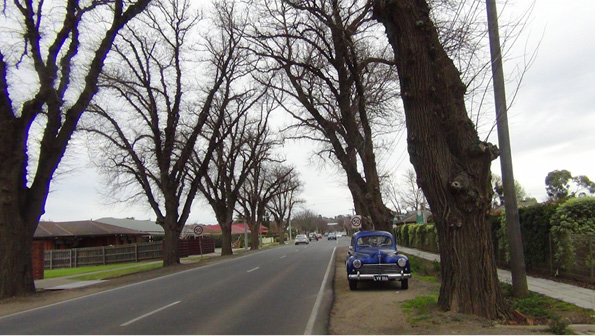
This 25th edition of the Moorabool Pocket Book is in the years 2014 and 2015. Both years are important hundredth anniversary years for Australia and for the Bacchus Marsh region of Victoria. (As well this is also an important milestone anniversary year for the Pocket Book Directory itself.)
On 28th June 1914 the Archduke Franz Ferdinand was assassinated in Sarajevo, Bosnia, leading to the 1st World War. The Archduke was heir to the Austrian-Hungarian throne. With the backing of Germany, and later Turkey, on 28th July 1914, Austria-Hungary declared war on Serbia to avenge the murder. A complex set of alliances led to the start of this European war, eventually involving other continents to become World War 1.
Australia's involvement started on 5th August 1914, the day after the English declaration of war on Germany, when the artillery battery at Fort Nepean in Victoria put a shot, the first for the Empire, over the bow of the 6,557 ton German cargo ship, SS Pfalz, as it was about to leave Port Phillip Bay, capturing the first enemy of the war.
German New Guinea was the next target. One story says that four Queensland police walked across from the Queensland colony of Papua and arrested the five German infantry guarding the German colony of New Guinea, taking the whole German colony in the process. But it is more likely that Australian army troops captured the German force led by captain Carl von Klewitz; the first Allied victory of World War One. In the biggest battle, on the 11th September 1914, the Australian naval and infantry forces attacked the wireless station at Bita Paka, near Rabaul, in New Pommern, later New Britain, suffering six dead and four wounded, while a German officer and 30 native police were killed and a German and ten natives were wounded. New Guinea and the Bismark Archipelago had been the first part of the short-lived German Empire, being occupied by them in 1884.
Of course, the real Australian activity started on 25th April 1915 with the invasion of Gallipoli, a small beach in the Dardenelles region of Turkey. This then is the next important centenary. Sitting back at Kew Vic's Burke Hall school in 1960, our grade three teacher, Pop Irish, would tell of his landing at Gallipoli, and tell the older boys at the school, just quietly, how his own brother was shot up on the boat in the place next to him. Some 62,000 Australians gave their lives during World War One.
The Australian forces went on to be the Allies' spearhead troops, under Australia's General Monash, throughout the western front in France. General John Monash was an engineer who redesigned the principle of the tank. His tanks could do the work required and, travel at speed! Later, Monash designed the Gippsland brown coal generating system. Monash University is named after him. See page 228 for section on Monash.
Bacchus Marsh, Myrniong, and whole Moorabool region, contributed men and supplies to the war effort. The RSLs and the Avenues of Honour are the living testament to the memory of these men and women and their families.
While the war did not officially end until 11am on the 11th of the 11th month 1918, citizens around Australia had been preparing for the boys to come home. Starting in June 1918, the Bacchus Marsh municipal council was leading residents in plans to create an Avenue of Honour for the servicemen who had enlisted from the district. A similar group was active at Myrniong.

On Saturday 10th August 1918, over a thousand people assembled along the two miles of the Avenue starting near Woolpack Rd. Commencing at the sound of a bugle, all 281 Elms were planted within half-an-hour. Already 211 plaques were ready. See list of names at the end of this article. The deciduous Elms had been selected as the Country Roads Board did not want the moisture-bearing evergreen trees potentially waterlogging the road.
While often referred to as Canadian Elms, the more official reports call the original 281 trees Dutch Elms (Ulmus x hollandica) and Huntington Elms (Ulmus x hollandica ‘Vegeta'), planted in pairs some 20 metres apart.
When the man has died during the war period, usually his last battlefield has been included. The following is the names dedicated on 280 of the trees:
In Turkey:
Allan, John William 1891-1953
Allan, William John Hutchison 1894-1966
Almond, James Meade 1886-1964
Anderson, Alfred Frank 1874-1948
Anderson, Keith Forsyth 1897-1972
Barrett, Alfred 1890-
Barry, Henry Theophilus 1899-1963
Barry, Patrick 1886-1971
Barry, Patrick Cecil 1890-1961
Barry, Percival Gregory 1897-1972
Barry, Richard Kevin 1888-1922
Bence, George Forsyth 1884-1975
Bennett, James Richard 1893-1979
Bennett, William 1895-1978
Bird, Charles William 1887-1963
Bird MM, Lionel Edgar 1889-1975
Blake, Edwin 1887-1967
Blake, Hector Norman 1899-
Blake, William Henry 1891-1960
Booth, Thomas Hart 1892-1917 at Hindenburg Line
Booth, William Chapman 1898-1973
Bottle, Edward John 1876-1923
Bottle, Henry Charles 1881-1917 at Ypres
Bottle, Hugh Joseph 1891-1916 near Ligny-Thilloy
Bourke, James Cassimer 1881-1955
Bourke, William Henry 1892-1959
Boyd, Joseph 1897-1955
Boyd, Raymond 1894-
Brennan, William 1893-1928
Brighton, Fred 1887-1939
Brunt, Isaac 1894-1929
Buckley, Albert Joseph 1889-1917
Buckley, James 1891-
Buckley, William 1896-1917 at Polygon Wood
Bushby, James Everard 1877-1920
Calderwood, John Robert 1888-1959
Cameron, George William 1880-1917
Campbell, Archibald Neil 1890-1942
Campbell, Gordon Leslie 1897-1983
Campbell, Henry Hodson 1893-1916
Campbell, John Henderson 1895-1917
Campbell, William Annesley 1892-1964
Cardell, John 1888-1978
Carter, Albert James 1895-1917
Carter, Walter William 1886-74
Cashmore, Edward Harold 1897-1973
Caspar, Frederick 1886-1917
Chambers, Francis 1899-1960
Chambers, Harold Heathcote Hayes 1895-1915
Chambers, John Herbert 1897-1958
Chippindall, William Giles 1896-1967
Claney, Alexander 1878-1945
Clark, Archbold (Archie) 1890-1916 at Fromelles
Clark, William 1894-1972
Coates, Richard Joseph Harrison 1884-1962
Cobham, Edwin 1890- 1916 at Pozieres
Coghlan, David James 1896-1983
Coghlan, Michael Bernard 1894-1972
Condon, Henry Andrew 1880-1948
Connell, James Daniel 1895-1966
Connell, William Henry 1896-
Connor, James Arthur 1881-1958
Cook, William Alfred 1890-1931
Cook, William Robert 1882-1949
Cosgrove, James 1885-1932
Cosgrove, Martin 1885-1936
Crook, Cecil Werribee 1890-1967
Crook, Charles Ernest 1896-1973
Crook, Francis Herbert 1889-1973
Crook, James Robert 1893-1967
Croton, Richard 1892-
Crouch, Robert Wallace 1892-1966
Crowe, David Millar 1889-1954
Cumming, Athol Kirkwood 1888-1966
Cumming, Charles Douglas 1873-1917 in Belgium
Cumming, Norman Hope 1896-1917 at Bullecourt
Cuthbertson DCM, Melville Robert 1893-1958
Davis, Archie Harry 1881-1947
Davis, George Thomas 1890-1916 at Pozieres
Davis, Leslie 1890-1980
Davis, Wilfred George Ernest 1898-1981
Davison, Alan Rutherford 1898-1971
Davison, James 1893-1917 at Polygon Wood
Davison, Norman David 1896-
Davison, Robert George 1894-1965
Dixon, William 1895-1955
Dodemaide, Frank 1891-1917 at Hindenburg Line
Dodemaide, Thomas Joseph 1894-1954
Drever, William Alexander 1892-1917 at Broodseinde Ridge
Dubout, Sydney Charles 1888-1937
Dubout, Vere 1889-
Dukelow, William Henry 1884-1915 at Gallipoli
Durward, Alexander 1891-1972
Earl, Clarence Joseph 1897-
Earl, Everett Belmont Graham 1894-1972
Edgerton, James Henry 1884-1917 at Vlamertinghe
Edgerton, William Albenia 1897-1986
Edols, Ross Worthington 1895-
Edwards, Charles Rupert 1892-1980
Edwards, Roy William 1888-1954
Edwards, William Bertrand 1894-1964
Emmett, John 1891-1915 at sea from Gallipoli
Emmett, Roy Meade 1897-1956
Evans, Reginald Robert 1895-
Fagg, James Beeching 1888-1970
Fairbank, Alfred Edmund 1888-1949
Farrow, Alfred George 1890-1965
George, Harold Thomas Victor 1897-1976
George, Herbert Ilot 1884-1916 at Pozieres
Gibson, Alexander James 1894-1918 at Mont St Quentin
Gladman, Charles Arthur 1894-1948
Godfrey MC, Thomas Charles Edward 1891-1917 at Broodseinde Ridge
Goudie, William 1872-1951
Grant, Harry Sutherland 1890-1936
Grant, Robert Thomas 1887-1964
Grant, Ross 1881-1957
Hammond, John William 1872-
Hanrahan, Cornelius 1888-1966
Harkness, Walter Scott 1882-1961
Hawkins, Thomas Leslie 1887-1965
Hine, Albert William Tyrrel 1894-1977
Hine, Alfred William 1896-1915 at sea from Gallipoli
Hogg, Robert John 1895-1982
Hollis, Daniel Garrett 1887-1971
Holman, Harry 1889-
Hopkins, Clive Boyer 1896-1916 at Fromelles
Horder, William Talbot 1889-1957
Johansen, James 1893-1918 in France
Johansen, John Edward 1890-
Johnston, William 1872-1916 in Belgium
Jones, Harold John 1894-1976
Jones, Percival Martin 1892-
Jones MM, Charles Arthur 1891-1935
Keddell, James Leslie 1891-1929
Kennelly, James Martin 1894-1916 at Mouquet Farm
Kerr, Grant McDonald 1889-1965
Kerr, Robert John 1884-1944
Kerr, William Robert 1891-1918 after Mont St Quentin
King, Herbert Joseph 1891-1967
Knight (Hallam), Alfred James 1891-1918 after Broodseinde Ridge
Ladhams, Arthur William 1897-1978
Lay MM, Fenton Henry 1890-1961
Leitch, Peter 1871-1943
Lindsay, David Sylvester 1895-1964
Lindsay, Robert James 1894-
Little, David 1893-
Little MC, Gerald Thompson 1890-1972
Little MC, Leo Paul 1892-1956
Love, Bernard Patrick 1887-1953
Low, Charles Alexander 1897-1969
Low, John Aitkin 1896-1957
Low, John Campbell 1895-1984
Lyle, Charles Lorne 1883-1917 at Heidelberg Hospital
Main, John 1888-
Manly, Thomas Henry 1896-1931
Marsh, Edmund Edward 1871-1943
Martin, Albert 1894-1916 at Bullecourt
McDougall, Sydney Victor 1895-1980
McFarlane, Herbert Galbraith 1876-1939
McFarlane, John Clement 1887-1974
McGregor, James 1883-
McGregor, John 1886-1955
McKenzie, Cleve Edward 1895-
McKenzie, William Samuel Alexander 1889-1970
McLachlan, John James 1889-1916 at Flers
McLachlan MC, Neil 1894-1918 at Rosieres Ridge
McPherson, John James 1894-1974
Medling, Walter Gordon 1893-1946
Minnett, Samuel 1891-1963
Mitchelson, George Squires 1894-1916 in France
Moffatt, Harry 1895-1949
Moffatt, Percy 1897-1981
Moon, Arthur Stapley 1894-1960
Moon VC, Rupert Theo Vance 1892-1986
Moore, David Roy 1897-1953
Moore, Francis Arthur 1892-1967
Moore, George 1890-1966
Moore, James Hogg 1899-1975
Moore, Kenneth Ernest 1896-1983
Moore, Peter 1889-1951
Morgan, George Bernard 1980-1956
Morley, Edwin Joseph 1885-1916 at Fromelles
Morton MSM, William Robert 1894-1924
Murcott, William Frederick 1883-1963
Murdoch, Alexander 1887-1915 after Gallipoli
Murphy, Thomas 1893-1917 at Polygon Wood
Nance, Francis Lyth 1888-1966
Nolan, John Patrick 1894-1939
Nolan, William Henry 1893-1941
Oliver, Charles Victor 1884-1935
Oliver, Edward Arthur 1894-
Oliver, Ernest Robert 1886-1916 at Fromelles
Oliver, Harrie Stacey 1897-1977
Oliver, Robert 1897-1918 in France
Oliver, Thomas 1892-
Orton, Edwin 1894-
Osborne, Percy Beaumont 1894-1917 at Tidworth
Osborne (McPherson), Sydney James 1893-1916 at Fleurs
Oswin, Percy 1894-
O'Brien DCM, Michael John 1879-
O'Hara, Arthur Nicholas Alfred 1897-1933
O'Leary, James 1890-1961
O'Leary, Thomas 1892-1915 at Gallipoli
Paterson, Arthur Benjamin 1898-1957
Paterson MM MC, George Gibson 1895-1983
Pezet, William John 1889-1968
Phillips, Thomas James 1897-1980
Phillips, Walter Terrence (Ted) 1893-1978
Pigott, Francis (Frank) Michael Joseph 1897-1973
Platt, William Henry 1889-1955
Platt MM, Charles Halford 1893-1955
Price MSM, Hubert George 1897-1959
Ramsey, Cyril Francis 1895-1917 at Polygon Wood
Ramsey, Roy McHugh 1895-1971
Rawlinson, Thomas 1889-1915 at Alfred Hospital
Reid, Robert Muir 1894-1954
Robson, George Cranstoun 1886-1954
Rogers, Kathleen Malvina 1864-1958
Rogers, William 1887-1918 at Hindenburgh Line
Ross, Duncan Alexander 1873-1952
Ross, John (Jack) William 1895-1958
Ruddick, Harry 1889-1964
Russell, Frederick 1891-1916 at Pozieres
Russell, Ivan John 1889-
Russell, Robert Joseph 1874-
Ryan, Edward Jeremiah 1892-1957
Ryan, James 1882-
Ryan, William Bernard 1885-1946
Serjeant MM, William Thompson 1879-1957
Shields, William Francis Waugh 1892-1915 in France
Short, John Stanley 1894-1918 at Corbie
Simmons, Thomas John 1896-1965
Simpson, Frederick Norman 1895-1916 at Armentieres
Simpson, Neil Patterson 1895-
Skene, Thomas Hamilton 1877-1929
Slack, Alfred George 1894-1917 at Hindenburg Line
Smith, Ernest (Ernie) Arthur 1894-1917 at Bullecourt
Smith, Gordon Thomas 1893-1916 at Fromelles
Smith, Melville Gardiner 1894-1916 at Pozieres
Smith, Richard Norman 1898-1961
Smith, Thomas Henry 1888-1916 at Flers
Smyth, John Charles (Charlie) 1876-
Somerton, Charles Henry 1876-1953
Stuart, John Ernest Athol 1877-1929
Sutton, George Hafferford 1880-1948
Swanton, Henry 1893-1916 at Fleurs
Symington, William Henry 1881-1971
Tancoe MM, John 1895-1973
Tinker, Francis John Lane 1897-
Todd, Colin McKellar (driver) 1894-1984
Todd, Colin McKellar (shoeing smith) 1894-1950
Todd, William Joseph 1898-1974
Toy, Frank Gundry 1894-
Tregoning, William James 1877-1917 at Bullecourt
Turnour, Arthur Wallace (Tom) 1879-1916 at Passchendaele
Turnour, James Owen 1883-1967
Turnour, John Edward Garth (Jack) 1883-1917 at Polygon Wood
Turnour, Keppel Ernest 1885-1946
Tyers, Alexander McKenzie 1895-1967
Usher, Alfred John 1885-1960
Usher, James Walter Henry 1887-
Usher, Mark 1891-1949
Vallence, Packington Joseph 1877-1926
Vallence MM, William 1881-1932
Vinning, John Henry 1889-1937
Ward, Francis Daniel 1896-1918 near Amiens
Warke, Thomas 1872-1921
Waterhouse, Thomas Charles 1886-1923
Watson, Henry (Harry) 1889-1944
Waud, Arthur Henry 1888-1966
West, John (Jack) Melville 1889-1960
West, Norman Stanley Robinson 1892-
West MM, Charles George 1887-1964
West MM, William Sims 1885-1965
Whelan, Maurice Joseph 1884-1961
Williams, Clifford (Cliff) Davies 1892-1917 at Broodseinde Ridge
Witham, Stanley 1892-1916 near Lille
Woodward, Albert 1894-
Of the 280 commemorated on the Bacchus Marsh Avenue of Honour, 117 were wounded in action, 4 were prisoners of war, 20 died of wounds, 4 died of disease and 40 were killed in action. A further 17 died before 1940, still at comparatively young ages.
Twenty-nine received awards, with 1 Commander-inChief congratulatory card, 2 Distinguished Conduct Medals, 5 Mention in dispatches, 2 Meritorious Service Medals, 5 Military Cross, 10 Military Medal, 1 Military Medal with Bar, 1 Recommended for Distinguished Conduct Medal, and 1 Victoria Cross.
While all are worthy of mention, the Hon. Capt. Rupert Theo Vance Moon was awarded the Victoria Cross for his actions at the Second Battle of Bullecourt on 12th May 1917.
Rupert was born in Bacchus Marsh on the 14th of August 1892 to Arthur Moon and Helen Dunning. Rupert had a brother, Arthur, who is also remembered in the Avenue. Rupert's citation reads:
“On the morning of 12th of May 1917, in portion of the HINDENBURG LINE East of BULLECOURT,
Lieut. MOON displayed most conspicuous bravery in an attack on a German strong point. His own immediate objective was a position in advance of the enemy trench. His orders were, having captured this, to move on to the trench itself, co-operate in the general attack in progress there, and in a further assault on another strong point immediately in rear. The full story is told by two eye-witnesses whose evidence is attached.
“Lieut. MOON was hit in the face when advancing to his first objective, which, after a sharp bomb fight, he captured.
“Leading his men, he engaged in the attack on the trench which the enemy held in force. Here he received another wound in the shoulder which spun him around and dazed him for a while. His men wavered and hesitated, but Lieut. MOON again rushed forward calling to his men “Come on, you'll not see me left, boy's. His men rushed after him, and the enemy broke and retired to the strong point in rear of the trench.
“Behind there was a sunken road where the enemy had a large dugout from which parties had continually been emerging to reinforce the defenders. Lieut. MOON'S party, now much diminished, fought on in the general attack, which was so strongly pressed that the enemy to the number of 184 surrendered. Lieut. MOON had by this time received another wound in the foot. Sitting down among his men with blood and sweat pouring from him he remarked “It was a hard fight boys, I've got three cracks and not one of them good enough for Blighty”. Then he busied himself with the consolidation of the captured position and went down into the sunken road where he received a bullet through the face fracturing his jaw. Only then would he consent to retire from the fight. His bravery was magnificent and was largely instrumental in winning a fight against superior numbers safeguarding the flank of the attack on BULLECOURT and gaining 184 prisoners and 4 machine guns.”
A day earlier than the Bacchus Marsh gathering, On Friday 9th August 1918, the Myrniong Avenue of Honour was planted on both sides of the Main St. This is reported as being with Japanese Flowering Cherries. (Japan was an ally in WW1.) A monument was also built in 1918 to honour the WW1 war dead; this later changed to honour the dead from all wars.
Further trees were planted west of Myrniong Creek following World War Two to remember those whom enlisted from the district for both wars. A memorial wall was later built and officially dedicated on 11th November 1999.
A replant of Avenue of Honour trees along both sides of the western approach to the town was carried out in 2001, with a dedication service held on 11th November 2001. (Some of these Scarlet Oak trees have not been successful with twelve of the fifty dying by 2004.)
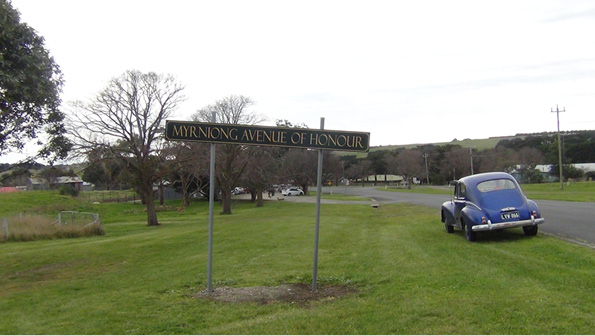
The Myrniong Avenue of Honour
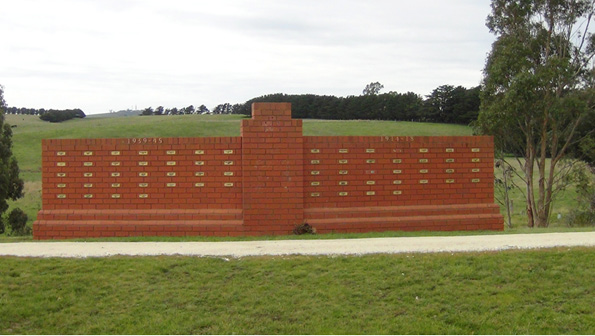
Myrniong Wall
The Rowsley Honour Roll lists those who served in the Second World War, 1939 - 1945:
R Arandt, J Banks*,
L Daff,
JL Davison*,
RJ Fagg,
J Fellon,
L Farrell,
J Fitzgerald,
P Fitzgerald,
Hazel Gordon (AWAS),
Jean Gordon (AWAS),
FR Hine,
R Hine,
N Horan,
K Horan,
W Kirby,
MS Manly,
RA Manly,
Elizabeth Moser (AAMWS),
L Mosel*,
L O'Keffe,
A Stewart,
GE Templeton,
CE Whitlow,
DW Whitlow,
GC Whitlow,
P Wilson,
R Wilson,
T Wilson.
* Supreme Sacrifice as killed in action.
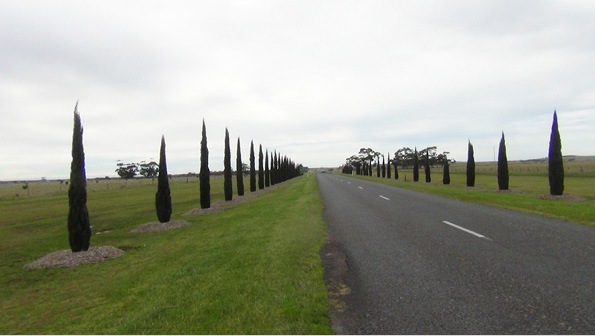
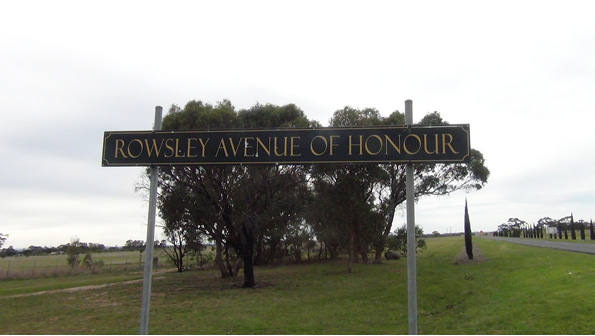
The Ballan Cenotaph, outside the post office, cites: “In Honour of the brave men of this district who fought for honour, freedom and justice in the Great war 1914-1919, AIF. “To honour those who served Australia in Korea 1950-1953, Malaya 1948-1960, Borneo 1962-1966, Vietnam 1960-1973”. “To the honour of the living and the everlasting glory of the dead who fought in the World War 1938-45. Lest we forget.”
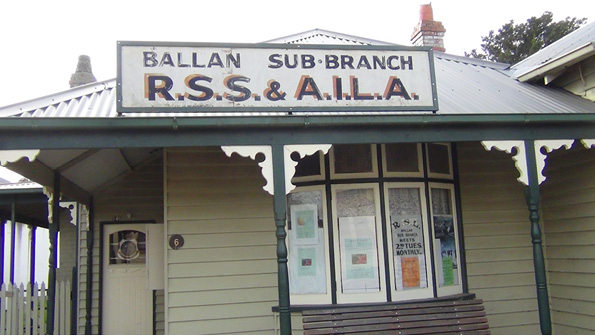
The 125 First World War names are listed in two sections. The 210 names from the Second World War and later wars follows. The first part is 1914-18 ‘Died on Service'
Berry JL
Binks C
Bond JH
Cowell G
Gibson AE
Hayes H
Lloyd R
Monks T
O'Shea W
Robbins C
Robertson G
Silling EG
Stephens I
Welch ER
Woods H
Young A
The WW1 larger list is those who served, and returned:
Alford JK
Allen CE
Anderson AW
Ashman E
Baker J
Barrett J
Bartlett CH
Bence A
Berry AR
Binks J
Body F
Chambers F
Chambers HR
Chambers JH
Corcoran AE
Cowell A
Cowell EAC
Cowell WDC
Crawford WJ
Cropley LL
Cullen V
Cullen WJ
Darragh TF
Day AJ
Denholm AW
Denholm WP
Densley WJ
Elliott GW
Elliott HL
Elliott MT
Fagg JB
Fisk J
Flack HH
Flack HN
Forbes RB
Fouracre RG
Fraser DR
Frichdt AJ
Gallagher HR
Graham JR
Graham WJC
Grieves J
Grieves S
Gurney H
Gurney W
Hall JH
Heath T
Hill FJ
Hill JA
Hodge JA
Hodge V
Hyatt RJA
Justice WCS
Kaneen EB
Kelly PLF
Kyle JA
Lacy HM
Laidlaw PCC
Lay EG
Lay F
Lay P
Lewis WJ
Lidgett RL
Lilburne AL
Lilburne EP
Linsdell RC
Lorkin J
Main AR
Maltby E
Marshall HJY
Marshall RW
McArthur A
McKenzie AD
McKenzie DW
McLean WA
Monks JM
Monks W
Myers D McP
Myers F
Nolan W
O'Brien MJ
Parker A
Paton FA
Peters VE
Pierpoint HJ
Platt C
Platt W
Purcell JJ
Purcell PC
Richard R
Robertson EG
Shankland RE
Simmons CH
Smallman JH
Spencer A
Stevens CR
Sugg C
Touhy MJ
Walsh OJ
Walters WL
Ward A
Watts GRA
Webster F
Webster F
Webster W
White A
Wilson R
Wilson R
Windsor NM
The 2nd World war names are listed in 3 sections.
The first special separate list is 1939-45.
Died on Service
Banks J
Blight L
Cula L. Cpln
Elstead G
Fitzgerald B
Fouracre J
Hogan T
Marendas N
McIntosh D
Monger E
Rhodes N
Shire of Ballan- Second World War:
The second and third lists are over two panels, but re-sorted here alphabetically, for the 2nd World War.
Even though the ‘Died on Service' has a separate list, the names have also been included within the main list:
(KIA is Killed in Action, POW is Prisoner of War, DOS is Died on Srvc.)
Shire of Ballan - 2nd World War
2ND AIF
Alexander J
Argent WH
Atchison N
Banks C
Banks J (KIA)
Binder W
Blight L (KIA)
Bone DA
Bone SJB
Bretherton FR
Bryant Ray
Bryant Ron (POW)
Cameron J
Cann VJ
Cantwell LF
Carroll J
Coates C
Coker K
Connor WJ
Conroy JD
Cooper JS
Cowell HA
Crawford CC
Cula L Padre (DOS)
Cullen CK
Davidson F
Davidson J
Davidson JA
Davis L
Delaney J
Devlin JK
Dickerson V
Douglas JG
Egan JJ
Elstead GE (KIA)
Fitzgerald J
Fouracre JL (KIA)
Fraser RM
Free H (POW)
Grano G
Hackett BR
Hall G
Harry ED (POW)
Hay RF
Heath E
Hedwards MT
Hodge J
Hogan E
Hotchin AL
Hunt JJ
Hutchison EEG
Jones B (POW)
Jones F
Kohn RH
Langdon H
Latter C
Lawes G
Lay NF
Lay NW
Leverett K
Lewis JAE
Lockwood AA
Lockwood IW
Lorensini E
Mackin MR
Mackin RJ
Marandas N (KIA)
Martin G
Martin R
Martinson JA DSM
Mayne FO
McCormack J
McIntosh DJ (KIA)
McIntosh J
McKenzie ED
Meldrum B
Meldrum W
Monger E (KIA)
Monks B
Morrish ER
Morrison R
Mullane JW
Musgrove NG
Myers LC
Nightingale R
Outhwaite J
Owens RO
Pettigrew WJ
Pollock HS
Prestt T
Pritchard A
Rhodes N (DOS)
Roberts GE (POW)
Robertson GA
Rooney W
Sharpley MA
Sherwell J
Shimmin CR
Spratling W
Stalker H
Stapleton HG
Stephens FG
Stringer OF
Surmon W
Tingate J (POW)
Toohey EJ
Trounce DA
Wall J
Wray LN
AWAS
Banks FAJ
Davis J
Marshall HM
McCormack M
Myers S
Quigley N
Webster P
RAAF
Bailey RP
Broadwood J
Butters CJ
Butters LO
Byrne L
Cameron FD
Cantwell BP
Coker JP
Connor CJ
Dawson M
Fagg I
Fitzgerald B (KIA)
Fitzgerald L
Fitzgerald M
Flack F
Fraser DD
Hodge MK
Hogan K
Hogan T (KIA)
Hook LW
Hunt GS
Jones T
Joughlin J
Kennedy JJ Padre
Lindsell RG
McLean AA
Marshall D
Martyn PM
Morris EJ
Mullane MD
Parkhurst R
Parslow EG
Pendergast IG
Pollock F
Sharpley NW
Stephens JH
Steward J
Stringer JH
Terrill WH
Varney W
Vorwerg J
Walker M
Wise P
Young TP
WAAF
Coombe L
Latter J
Leverett MR
Muhlhan I
RAAF Nursing Srvce
Marshall ML
McKee JH
Tingate E
AMF
Anderson J
Bence AJ
Cantwell RK
Cooper A
Guppy E
Lee A
McKenzie W
Marshall N
Molesworth JB
Moore H
Ryan JM
Paulden W
Slocombe AE
Slocombe R
Slocombe SG
Spinner C
Stevens L
RANavy
Keating J
Lenaghan BK
Mackin TH
Stephens R
WRAN
Lockwood HJ
MERCHANT Navy
Clark J
Smallman E
Spencer B (POW)
AAMWS
Flack G
Hodge ZD
Lilburne A
KOREAN WAR
Collins John
VIETNAM WAR
Parkinson John
Patmore Thomas
Young Ray
The Blackwood memorial is on the corner of Byres Rd and Martin Sts. The inscription is “In proud memory of those men and women who served in World War II and of those who passed from the sight of man.” “Lest We Forget”.
Bacchus Marsh had already been active in preserving the memories of its troops. A memorial was mooted in March 1901 to honour the Boer War contingent. Just eight months later, in November 1901, the above fountain monument was unveiled, six months before the end of the South African War. While Mr Samuel Thomas Straughton MLA (Member of the Legislative Assembly of the Parliament of Victoria) was the major donor, the general public were asked to make a non-burdensome subscription of one shilling, with school children also contributing. Thus the whole town was involved.
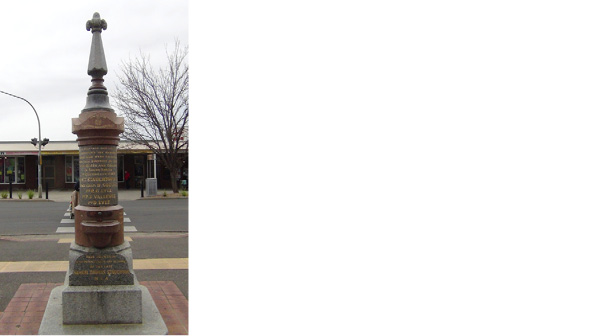
The Vietnam War troops are remembered by the Vietnam Memorial Tree planted in Maddingley Park, near the Tennis Courts. The Vietnam conflict lasted from from 3rd August 1962 until 11th January 1973, although virtually all troops had been withdrawn by the Liberal Bill McMahon Government with McMahon's ending of conscription in early 1972. This was almost a year before the inauguration of the Labor Gough Whitlam Government in December 1972 when he removed the 1943 Act of Parliament allowing conscription. (The date for the end of the Vietnam War is also given as 1975 when the North Vietnamese army defeated the South Vietnamese army at Saigon.)

Returned Services Leagues built halls in Bacchus Marsh, Myrniong, Ballan, Balliang and Balliang East.
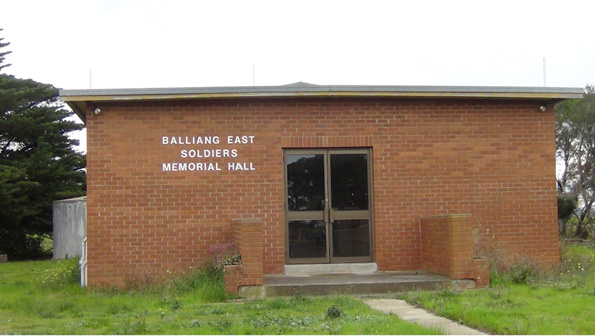
A solid red brick building would have been ‘very modern' in 1929 and 1930 when this Soldiers memorial hall was built in Balliang East. It was opened in April 1930 by Mr Angliss MLC (Member of the Legislative Council of the Victorian Parliament.)
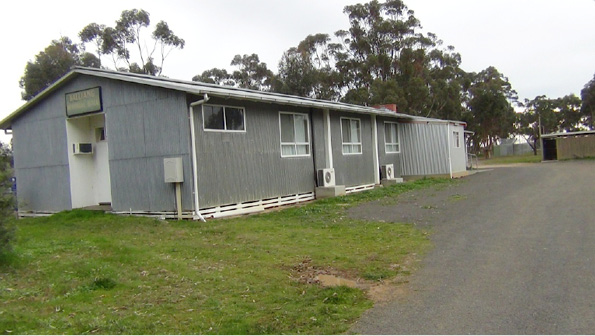
Balliang has a Avenue of Honour, as well as this Memorial Hall. While this is a corrugated iron shed, considerable work has been done with concrete block stumps and air conditioning. Cyclone experience in Innisfail and Tully, Qld, shows that this type of structure stands up very well in big storms and winds.
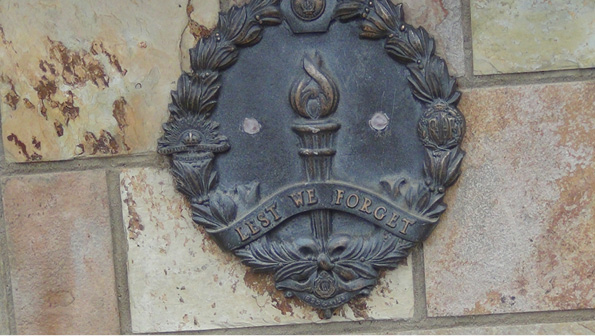
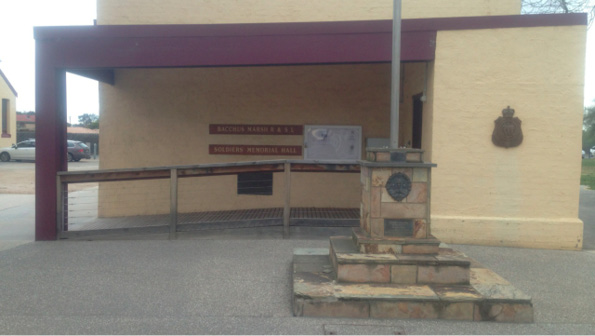
The Bacchus Marsh RSL rooms also have their memorial just in front of the building. Their plate reads “Erected by the people of the Shire of Bacchus Marsh in recognition of those who served their country in war”.
Being built a bit later than some of the other halls, this epitaph is inclusive of both the ‘men who went to war' and those women who went to war, especially as support staff and nurses, like Kathleen Rogers. Kathleen has a tree in the Avenue. The wording also includes the older men, and women of all ages, who stayed at home running the farms and supply machines of industry and the economy.
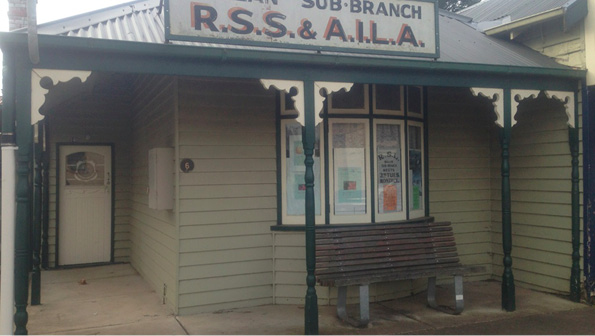
The Ballan RSL meeting rooms were often visited by my father, Calvert Croxson Clarke, 1914-2013, who lived at The Dome, with my twin brother, Anthony, in the later years of his life. He had served in many second world war battle grounds in the Middle East.
On returning to Australia, many soldiers were offered land and finance packages to establish farms and lifestyles. These soldier settlement blocks were a feature of parts of the now current Moorabool Shire district. Some local soldiers went as far as Red Cliffs, near Mildura, to take up a settlement block.
The Larundel Soldier Settlement Plaque is on Map C at C6, at the corner of Orrells Rd and Mt Mercer - Elaine Rd Cargerie, near Elaine, close to the St Salva monastery. This plaque, erected on 17th February 2002, commemorates 50 years of soldier settlement in the district from February 1952 till February 2002.
The land blocks for second world war returned men were larger than those for the first war settlers with carefully selected roads, housing and fences.
Often the First World War soldiers would be placed to take advantage of a cool dry climate, which was valued in the early twentieth century as an aid to health; especially as an aid to those suffering from tuberculosis and chest conditions, and those soldiers recovering from mustard gas exposure. However, sometimes the blocks had been too small to properly support a family.
Ballan also hosted an extensive Soldier Settlement Scheme.
This settlers' rememberance plate is near the Ballan RSL rooms, showing the names of the Second World War returnees “who settled with their families as farmers in the Ballan District” and “They served in war and peace”.
Beremboke Estate: Bill Connor AIF, John Ritchie AIF, Jim Woods AIF.
Ingliston Estate: Pat Bolton AIF, Tom Burns AIF, Keith Claney AIF, John Copeman RAAF, Neville Denning AIF, Jack Geary RAAF, Eric Gillett RAN, Bill Hoddinott RAAF, John Laney AIF, Jack Minion AIF, Ed Peucker AIF.
(AIF is Australian Imperial Forces, which later was often referred to as Australian Infantry Forces.; indeed, the heading at the top is Australian Imperial Force, which encompasses all three services. RAAF is Royal Australian Air Force. RAN is Royal Australian Navy.)

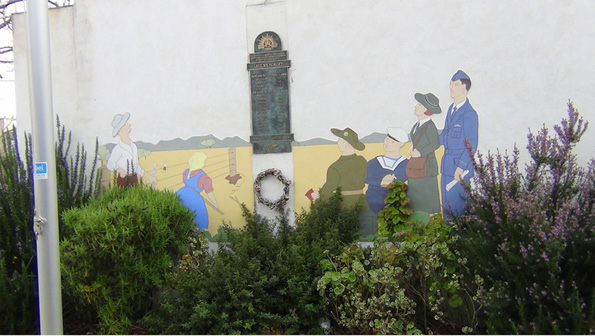
The records of Australian War Memorial in Canberra provide a moving story about Sir John Monash:
Born 27th June 1865 at Dudley St West Melbourne, died 8th October 1931 at Melbourne, aged 66. Final rank was General. John's parents were originally from Prussia in Poland, and John spoke fluent German, as well as English.
“John Monash is considered one of the war's outstanding commanders. Monash was born in Melbourne on 27 June 1865. (At 16), he was dux of Scotch College and studied arts and engineering at Melbourne University, where he was also involved in debating and student politics. Outside of university he dabbled in acting. In 1884 he joined the university company of the 4th Battalion, Victorian Rifles.
“Monash was a driven young man, ambitious and intelligent. He worked on the construction of the Princes Bridge in Melbourne and in 1888 was placed in charge of constructing a new railway even though he had yet to complete his degree. Monash married Hannah Moss in April 1891, finished his studies in 1895 and, having long since decided to combine engineering with a military career, was promoted to captain in the Garrison Artillery that year. In 1897 Monash was promoted to major in the North Melbourne Battery and served there for 11 years.
“Meanwhile, he and a friend had established a private engineering practice in 1894.
The business grew steadily but a series of setbacks left him with large debts in 1902. Starting again, Monash recovered and his business prospered. He also gained promotion to lieutenant colonel in the Australian Intelligence Corps in 1908 and in 1913 took command of the 13th Infantry Brigade.
“After the outbreak of war, Monash was given command of the AIF's 4th Infantry Brigade, landing at Gallipoli on 26 April 1915. In July he was promoted to brigadier. Despite having encountered some criticism for his performance on Gallipoli, Monash took his brigade to France in June 1916. He became a major general in July and took command of the 3rd Division. The division's first major battle, Messines, was hailed as a great success. Further success followed and in May 1918, Monash was promoted to lieutenant general and given command of the Australian Corps. His first battle in this role, Hamel, of which he wrote: 'the operation is a striking example of the success which invariably results from careful preparation and coordinated action: and will serve as a model and the standard of the fighting efficiency of the Australian corps'. Monash remained in command through the victorious battles in the last months of the war. He was an innovative leader who earned high praise from many leading political and military figures.
“After spending eight months in London overseeing the repatriation of the AIF, Monash was welcomed home in Melbourne by an enthusiastic public on Boxing Day 1919. He returned to business and in 1920 became manager of Victoria's State Electricity Commission. An advocate for returned soldiers, Monash also held a range of high-level positions. His opinions were widely sought and he became a leading figure in Melbourne's Jewish community.
“Monash died of heart disease in Melbourne on 8 October 1931 and was given a state funeral attended by some 250,000 mourners.”
I would like to thank you for reading this longer-than-usual front cover story. For quite a few years, I have been waiting for the opportunity for this type of story. This year's centenary anniversary is the correct year, although next edition would also have been appropriate.
I thank my twin brother, Anthony, for taking nearly all these photos in early August 2014. His French 1954 Peugeot 203 car was close to the vintage needed for this work.
My apologies for not being able to bring all the names on all the monuments.
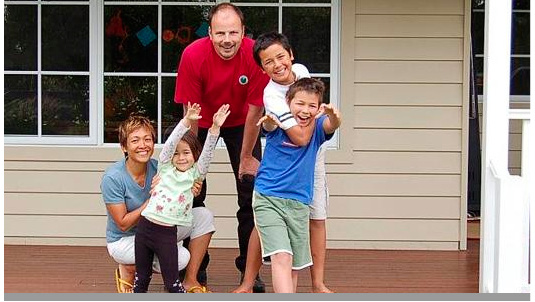
The thought of war, and its rememberance, is really never far away. Since Vietnam, our troops, and our police, have been to Cyprus, Rwanda, Timor, Solomons, Iraq, Afganistan, and recently to the shot-down MH17 jetliner crash site in Ukraine.
This last is of particular importance to Bacchus Marsh with the tragic loss of the Van den Hende family from Eynesbury. Hans, 45, Shaliza, 45, Piers 15, Marnix 12 and Margaux 8, were returning from the Netherlands.
The children attended Bacchus Marsh Grammar school, where some 700 came for their memorial service. The assistant principal, Andrew Mackenzie said the school would plant a tree in their honour. Without really cognising this, the planting of such a living symbol of a tree for these latest victims of war summarises the continuing method in which the Bacchus Marsh community shows its character of caring and rememberance.
Even the former premier, Ted Baillieu, would have been closer to this than many realise. His company had developed the Eynesbury estate.
Gerry Clarke B.PED